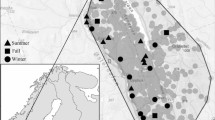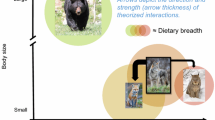Abstract
Scavenging is an important but poorly understood ecological process. Dominant scavengers can impose a selection pressure that alters the predator’s fitness, morphology, behavior, and ecology. Interactions between ursids, likely the most important dominant scavengers in the Holarctic region, and solitary felids, which are characterized by long feeding times, provide a good opportunity for studying the effects of kleptoparasitism by dominant scavengers. We analyzed the effects of scavenging by brown bears Ursus arctos on Eurasian lynx Lynx lynx and predator’s response to kleptoparasitism in a European temperate forest ecosystem. Bears found 32 % of lynx prey remains and 15 % of all biomass of large prey killed by lynx was lost to bears. In response, lynx increased their kill rate by 23 % but were able to compensate for only 59 % of the losses. The frequency of bear scavenging was strongly dependent on bear activity patterns and was highest during the lynx pregnancy and lactation period, when up to half of lynx kills were usurped by bears. We suggest that ursid scavenging, by promoting the hunting of smaller prey, may have played an important role in the evolution of the Lynx genus as well as other predators in the Holarctic. Our study indicates that prey loss to dominant scavengers is a widespread phenomenon among felids worldwide, including forest habitats. We highlight several implications of scavenging that could considerably improve our understanding of the ecology of vertebrate communities and the evolution of predators as well as benefit the future management and conservation of endangered predators.


Similar content being viewed by others
References
Bailey TN (1993) The African leopard: a study of the ecology and behavior of a solitary felid. Columbia University Press, New York
Ballard WB, Carbyn LN, Smith DW (2003) Wolf interactions with non-prey. In: Mech LD, Boitani L (eds) Wolves: behavior, ecology, and conservation. The University of Chicago Press, Chicago, pp 259–271
Bissett C, Bernard RTF (2007) Habitat selection and feeding ecology of the cheetah (Acinonyx jubatus) in thicket vegetation: is the cheetah a savanna specialist? J Zool 271:310–317
Breitenmoser U, Breitenmoser-Würsten C (2008) Der Luchs: Ein Grossraubtier in der Kulturlandschaft. Salm, Wohlen
Carbone C, DuToit JT, Gordon IJ (1997) Feeding success in African wild dogs: does kleptoparasitism by spotted hyenas influence hunting group size? J Anim Ecol 66:318–326
Caro TM (1994) Cheetahs of the Serengeti Plains: group living in an asocial species. Chicago University Press, Chicago
Cooper SM (1991) Optimal hunting group-size: the need for lions to defend their kills against loss to spotted hyaenas. Afr J Ecol 29:130–136
Creel S, Spong G, Creel N (2001) Interspecific competition and the population biology of extinction-prone carnivores. In: Gittleman JI, Funk SM, Macdonald DW, Wayne RK (eds) Carnivore conservation. Cambridge University Press, Cambridge, pp 35–60
Dahle B, Swenson JE (2003) Seasonal range size in relation to reproductive strategies in brown bears Ursus arctos. J Anim Ecol 72:660–667
Derocher A, Wiig Ø, Andersen M (2002) Diet composition of polar bears in Svalbard and the western Barents Sea. Polar Biol 25:448–452
DeVault TL, Rhodes OE, Shivik JA (2003) Scavenging by vertebrates: behavioral, ecological, and evolutionary perspectives on an important energy transfer pathway in terrestrial ecosystems. Oikos 102:225–234
Gorman ML, Mills MG, Raath JP, Speakman JR (1998) High hunting costs make African wild dogs vulnerable to kleptoparasitism by hyaenas. Nature 391:479–481
Hebblewhite M, Smith DW (2010) Wolf community ecology: ecosystem effects of recovering wolves in Banff and Yellowstone national parks. In: Musiani M, Boitani L, Paquet PC (eds) The world of wolves: new perspectives on ecology, behaviour and management. University of Calgary Press, Calgary, pp 69–120
Herrero S (2002) Bear attacks: their causes and avoidance, 2nd edn. Nick Lyons, New York
Hunter JS, Durant SM, Caro TM (2007) To flee or not to flee: predator avoidance by cheetahs at kills. Behav Ecol Sociobiol 61:1033–1042
Iyengar EV (2008) Kleptoparasitic interactions throughout the animal kingdom and a re-evaluation, based on participant mobility, of the conditions promoting the evolution of kleptoparasitism. Biol J Linn Soc 93:745–762
Jędrzejewska B, Jędrzejewski W (1998) Predation in vertebrate communities: the Białowieża Primeval Forest as a case study. Springer, Heidelberg
Jędrzejewski W, Schmidt K, Milkowski L, Jędrzejewska B, Okarma H (1993) Foraging by lynx and its role in ungulate mortality—the local (Białowieża Forest) and the Palearctic viewpoints. Acta Theriol 38:385–403
Jobin A, Molinari P, Breitenmoser U (2000) Prey spectrum, prey preference and consumption rates of Eurasian lynx in the Swiss Jura Mountains. Acta Theriol 45:243–252
Kortello AD, Hurd TE, Murray DL (2007) Interactions between cougars (Puma concolor) and gray wolves (Canis lupus) in Banff National Park, Alberta. Ecoscience 14:214–222
Krofel M (2011) Monitoring of facultative avian scavengers on large mammal carcasses in Dinaric forest in Slovenia. Acrocephalus 32:45–51
Krofel M, Kos I (2010) Modeling potential effects of brown bear kleptoparasitism on the predation rate of Eurasian lynx. Acta Biol Slov 53:47–54
Krofel M, Kos I, Linnell JDC, Odden J, Teurlings I (2008) Human kleptoparasitism on Eurasian lynx (Lynx lynx L.) in Slovenia and Norway. Varstvo Narave 21:93–103
Krofel M, Filacorda S, Jerina K (2010) Mating-related movements of male brown bears on the periphery of an expanding population. Ursus 21:23–29
Krofel M, Huber D, Kos I (2011) Diet of Eurasian lynx Lynx lynx in the northern Dinaric Mountains (Slovenia and Croatia): importance of edible dormouse Glis glis as alternative prey. Acta Theriol 56:315–322
Kurtén B (1968) Pleistocene mammals of Europe. Weidenfeld and Nicolson, London
Kurtén B (1978) Lynx from Etouaires, Lynx issiodorensis (Croizet and Jobert), Late Pliocene. Ann Zool Fenn 15:314–322
Mattisson J, Andrén H, Persson J, Segerström P (2011) Influence of intraguild interactions on resource use by wolverines and Eurasian lynx. J Mammal 92:1321–1330
Mattson DJ (1997) Use of ungulates by Yellowstone grizzly bears Ursus arctos. Biol Conserv 81:161–177
Merrill E, Sand H, Zimmermann B, McPhee H, Webb N, Hebblewhite M, Wabakken P, Frair JL (2010) Building a mechanistic understanding of predation with GPS-based movement data. Philos T R Soc B 365:2279–2288
Mills MGL, Broomhall LS, du Toit JT (2004) Cheetah Acinonyx jubatus feeding ecology in the Kruger National Park and a comparison across African savanna habitats: is the cheetah only a successful hunter on open grassland plains? Wildl Biol 10:177–186
Murphy KM, Felzien GS, Hornocker MG, Ruth TK (1998) Encounter competition between bears and cougars: some ecological implications. Ursus 10:55–60
Nilsen EB, Linnell JDC, Odden J, Samelius G, Andrén H (2012) Patterns of variation in reproductive parameters in Eurasian lynx (Lynx lynx). Acta Theriol 57:217–223
Palomares F, Caro TM (1999) Interspecific killing among mammalian carnivores. Am Nat 153:492–508
Pigeon K (2011) Denning behaviour and climate change: linking environmental variables to denning of grizzly bears in the Rocky Mountains and boreal forest of Alberta, Canada. In: Stenhouse G, Graham K (eds) Foothills Research Institute Grizzly Bear Program. 2010 annual report. Hinton, Alberta, pp 11–25
Ross PI, Jalkotzy MG, Daoust P-Y (1995) Fatal trauma sustained by cougars, Felis concolor, while attacking prey in southern Alberta. Can Field Nat 109:261–263
Selva N, Jędrzejewska B, Jędrzejewski W, Wajrak A (2003) Scavenging on European bison carcasses in Bialowieza Primeval Forest (eastern Poland). Ecoscience 10:303–311
Selva N, Jędrzejewska B, Jędrzejewski W, Wajrak A (2005) Factors affecting carcass use by a guild of scavengers in European temperate woodland. Can J Zool 83:1590–1601
Stander PE, Haden PJ, Kaqece Ghau (1997) The ecology of asociality in Namibian leopards. J Zool 242:343–364
Stankowich T, Caro T, Cox M (2011) Bold coloration and the evolution of aposematism in terrestrial carnivores. Evolution 65:3090–3099
Stillman RA, Goss-Custard JD, Caldow RWG (1997) Modelling interference from basic foraging behaviour. J Anim Ecol 66:692–703
Trinkel M, Kastberger G (2005) Competitive interactions between spotted hyenas and lions in the Etosha National Park, Namibia. Afr J Ecol 43:220–224
van der Meer E, Moyo M, Rasmussen GSA, Fritz H (2011) An empirical and experimental test of risk and costs of kleptoparasitism for African wild dogs (Lycaon pictus) inside and outside a protected area. Behav Ecol 22:985–992
von Arx M, Breitenmoser-Würsten C, Zimmermann F, Breitenmoser U (2004) Status and conservation of the Eurasian lynx (Lynx lynx) in Europe in 2001. KORA Bericht No. 19. KORA, Muri
Vucetich JA, Peterson RO, Waite TA (2004) Raven scavenging favours group foraging in wolves. Anim Behav 67:1117–1126
Werdelin L (1981) The evolution of lynxes. Ann Zool Fenn 18:37–71
Wilson EE, Wolkovich EM (2011) Scavenging: how carnivores and carrion structure communities. Trends Ecol Evol 26:129–135
Wilton ML (1986) Scavenging and its possible effects upon predation—a selective review of literature. Alces 22:155–180
Acknowledgments
We would like to thank M. Jonozovič, F. Kljun, A. Marinčič, H. Potočnik, N. Ražen, T. Skrbinšek, and A. Žagar for their help with the fieldwork and A. Majić Skrbinšek for project coordination. We are also grateful to N. Selva, who reviewed the early draft and gave us several helpful suggestions, to T. Caro and M. Festa-Bianchet for suggesting further improvements, and to P.J. Nagel for improving the English. This study was partly financed by the European Union through INTERREG IIIA Neighbourhood Program Slovenia/Hungary/Croatia 2004–2006 (project “DinaRis”) and by the Slovenian Research Agency (project P1-0184), Ministry of Agriculture, Forestry and Food (project V4-0497) and the Slovenian Environmental Agency (projects no. 2523-09-100075 and 2523-08-100547).
Ethical standards
The work complies with the current laws of the country in which they were performed. Procedures involving handling of lynx and bears were permitted by the Slovenian Environmental Agency (permissions no. 35601-45/2006-6 and 35601-167/2008-4).
Author information
Authors and Affiliations
Corresponding author
Additional information
Communicated by M. Festa-Bianchet
Electronic supplementary material
Below is the link to the electronic supplementary material.
Example of kleptoparasitism by a brown bear on a female Eurasian lynx recorded with an automatic night-vision video system in the Dinaric Mountains in Croatia. The bear usurped the carcass of a male roe deer that was killed by the female lynx 3 days before the recording. The bear spent 35 min eating the carcass and later moved it a few meters from the kill site, where it consumed it completely before the lynx returned. (WMV 12142 kb)
Rights and permissions
About this article
Cite this article
Krofel, M., Kos, I. & Jerina, K. The noble cats and the big bad scavengers: effects of dominant scavengers on solitary predators. Behav Ecol Sociobiol 66, 1297–1304 (2012). https://doi.org/10.1007/s00265-012-1384-6
Received:
Revised:
Accepted:
Published:
Issue Date:
DOI: https://doi.org/10.1007/s00265-012-1384-6




